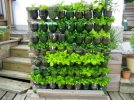This is an excellent, comprehensive book for DIY, simple living off the land. I believe there is a downloadable version.
Joel Skousen's weekly news analysis newsletter always has an excellent prepping section at the end. Worldaffairsbrief.com. If you write to him, I think he will send a free sample. If you subscribe, you will have access to all of them. He has some very good books like Strategic Relocation, and The Safe Home, both written with the coming hard times in mind.
Example prepping subjects are laundry systems, infection control, off-grid communications, water access and purification systems, seed saving and food growing, food storage and rotation, nutrition and natural medicines, building safe communities, etc.
Here is the preparedness section from this weeks newsletter:
PREPAREDNESS TIP: 80 PERCENT LOWERS by Andrew Skousen
The first step toward banning civilian ownership of firearms is to register all their guns. Nearly all firearms manufactured
since 1968 are required to have a serial number printed on the weapon allowing the weapon to be traced to its original manufacturer and, depending on state law, also traced to every owner. Background check laws have done very little to stop guns from ending up in the wrong hands, but they do result in a record of who buys a firearm and even which weapon they own. Anyone with an FFL (Federal Firearm License) must perform a background check before buying, selling or trading a firearm per federal law. Most states do not yet have a “universal background check law” so individuals can still sell their own weapons with less restrictions but that is likely to change in the near future with a Biden administration and a leftist congress.
Another loophole that will soon be closed off soon is the exception for homemade weapons. Anyone can legally
make their own firearm without a serial number provided the weapon is not sold to others. Considering various parts on any weapon can be changed out like the trigger, barrel, slide, firing pin, etc., the part that is legally “the firearm” is the lower receiver. This is the framework around the trigger that all the other parts are connected to, and so this part is required to have the license number printed on it. Legally, if you manufacture at least 20% of this part you have legally “manufactured” your own firearm and are not required to have a serial number or record your weapon. Because of this loophole a market has grown around selling this part with all but 20% of it completed. “80% lowers” are sold with or without the jigs and tools to finish the manufacturing process. Sellers will also happily sell you the rest of the parts to form a complete weapon, or you can salvage them from another complete weapon you have.
Manufacturing a part for a firearm in your shop or garage might sound daunting, but the truth is with a good jig almost anyone can complete the process using just a power drill and a router. The lowers are made from either aluminum or polymer plastic that is carved out easily and quickly by a power tool with carbide bits. The best jigs simplify the process so it only takes an afternoon the first time and as little as 30 minutes once you know the process.
There are many manufacturers of 80% lowers. Here is
a review of some of the best options. Most lowers are for rifles: AR-15, AR-10 / .308 (the AR-10 platform is not as standardized as AR-15, so verify all parts), AR-9 and even
22lr. There are also a few pistol options:
Glock 9 and 40, Sig P320, and (of course) the popular 1911 (
double-stack or single stack). Manufacturers are expanding into other weapons, so search for the kind of weapon you are looking for (or already own).
Aluminum lowers are more expensive but they are more durable than the polymer plastic lowers. Grade 6061 billet aluminum is adequate for lifetime warranties and is easier to mill than the tougher 7075-T6 grade aluminum, but either are acceptable. Polymer plastic is not mil-spec like aluminum, but it is lighter, cheaper, corrosion resistant and easier to mill. The high grade reinforced polymer from James Madison Tactical and Polymer80 are the better options in this category. They come with their own jigs for around $100 (you provide your own tools).
Aluminum lowers will need a good jig kit to complete. You can get aluminum lowers with a jig but few of these jigs have good reviews. Good quality universal jigs like those from
5D Tactical are over $200 but their professional setup makes the process fast and easy—ideal if you need to make multiple lowers. Their
AR-15 jig is $220 and the
multiplatform jig (for AR-15, AR-10, and AR-9) is $289. You will also need to buy the tool kit with the
router-specific milling bit for $55.
Don’t be discouraged by the idea of manufacturing your own weapon part. These mostly completed lower receivers make the process very straightforward to finish. I recommend everyone make one to replace the serial number version on every weapon they own (that they can). There are multiple ways to avoid a weapon roundup but surrendering the part with the serial number is a foolproof option with this loophole. Don’t wait to take advantage of this opportunity. Most websites are already backordered by 5 or 6 weeks, and the ATF has already tried to intimidate the maker of
Polymer80 products with a raid recently. Polymer80 is a big manufacturer of 80% polymer lower receivers, showing that the PTB have this loophole in their sights so it
won’t be around for long. [END]
 www.almanac.com
www.almanac.com

